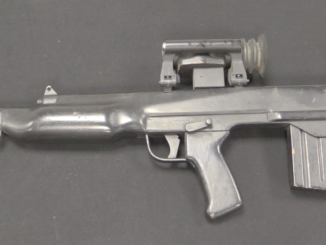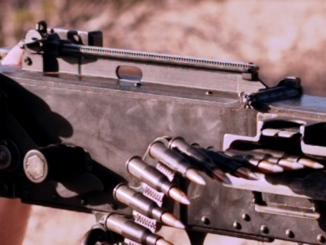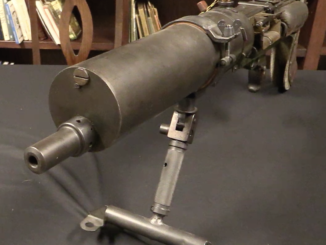The Vickers MkI No2 was an improvisation of the British Royal Air Force. They needed arms for airbase defense, without unduly impacting the production of weapons for the infantry. Wheat they had a good supply of were Vickers Gas-Operated (aka Vickers K-class) guns that had been used in now-obsolete aircraft with flexible observers’ guns. And so, the MkI No2 was a Vickers Gas-Operated outfitted with a buttstock, pistol grip, and bipod. Voila! An infantry MG!
I have found no accounts of how they handled in use, but one must assume they were not great. Despite looking really cool, they have basically no functional cheek rest and a rather high rate of fire (thanks to their aircraft gun lineage). Still, in addition to airbase use these guns found their way into service in Normandy (with No4 Commando), Norway, and the invasion of the Walcheren Islands. When the war ended, they were not kept in service, as they were a small number of non-standard weapons.
Many thanks to the Royal Museum of the Armed Forces and Military History in Brussels for access to this very rare piece! Check them out here:
https://www.klm-mra.be/D7t/
A couple photos of the guns in action and the mag-carrying gear can be seen at the Vickers MG Blog:




I’d call it slightly more ergonomic than an SA80.
The standard VGOs with the integral pistol grip at the rear mostly ended up with the LRDG and SAS in the Western Desert. In single or paired mounts, they were generally well-suited to what the raider units wanted a machine gun to do; send a lot of bullets downrange as quickly as possible. Firepower substituted for manpower. (Hmm. Where have we heard that one before, and didn’t it have a German accent?)
Of course, that wasn’t the only “borrowing” they did from the RAF. The .50 Browning MGs they used had full-length perforated cooling jackets. Meaning, they were AN/M3 Brownings taken off Lend-Lease B25 Mitchells or etc., flexible waist guns with a 1,200 R/M rate of fire. The RAF didn’t think much of the “flexible gun” concept, but this worked to the raiders’ advantage.
cheers
eon
“(…) Lend-Lease B25 Mitchells or etc.(…)”
Also part of B-24 were rebuilt to assembly ship configuration, guns were removed and geometrical shapes painted, see 4th image from top https://www.vintagewings.ca/stories/polkadotwarriors
B-24 assembly ships were primarily used by USAAF bomber command.
OTOH British B-24 Liberators exploited their long range during anti-submarine patrols over the North Atlantic Ocean. B-24s are credited with closing the North Atlantic Gap during the Battle of the Atlantic. Early in the war, U-boat captains learned to avoid WALLIED convoys protected by aircraft, even USN blimps. While airplanes (B-17, B-18, B-24, Hudson, Catalina, Sunderland, etc.) might attack with bombs, depth-charges or torpedoes, their greatest weapon was radios to call in escorting corvettes and destroyers who had the endurance to force U-boats to stay submerged for many hours … depleting their batteries.
In the Far East, British B-24s used their long range to drop spies and partisans into Burma, Viet Name, etc.
If the overall package hasn’t been optimized for a ground-based crew, then clearly it won’t be a success with the infantry. I think Kirk would agree with me on this: If you want to adapt an aircraft machine gun to ground use, develop and test the freaking field kit. I could be wrong.
I’d suggest that there’s another thing going on here, with these guns: The user-driven quest for more firepower.
It’s similar to the Marine improvisations in the Pacific Theater with regards to the so-called Stinger MGs adapted from aircraft-mounted Brownings.
I have my doubts about the supposed virtues of low rate-of-fire MGs in infantry combat. Actual veterans wanted higher rates of fire; they went so far as to adapt these things deliberately, in more than few cases. I think they knew what they wanted, and they had what they thought were good reasons.
I’d really like to interview some of the users of these adapted Vickers-K weapons, and find out just why the hell they thought the squeeze was worth the juice, so to speak. I’d wager that they’d articulate a lot of the same reasons the Germans who were doing the same damn thing would. Don’t forget, the successor to the MG42 was supposed to have a higher rate of fire than it did, ideally somewhere around 1500rpm.
There were legit reasons they all wanted that, and whether it was down to collective delusion or whatever, the UK, the US, and the Germans were all doing the same thing: Desire-path adaptation of high rate-of-fire weapons for combat application.
Could have just been down to a desire for “More Dakka”, but I suspect there were carefully thought-out reasons they all went for this.
Either that, or they just really liked the sound of the guns at those high rates of fire.
Sorry for my pedantry, but either your or the book header is wrong.
As far as I know, “Number” came first, followed by modifications designated “Mark”.
Maybe the RAF used somethig else.
Actually, JPeelen, the question of MK / NO. sequence in the VGO is even more complicated, as your pointing to its irregularity has nothing in common with pedantry. What Ian shows is actually called a “Vickers Gas Operated Mark I No.2 Mk1 (Land Service)” gun, and is a Commando-specific conversion of the original RAF’s GO Mark I No.2. The original Mark I No.2 was an air force land-based AA defence variant, covered in manuals as early as 1940 (early enough to make it into mine earliest edition, which is the the Finnish translation dated October 1940).
The ground version was present from the very beginning of the VGO, as early as 1937, when the gun was introduced into the inventory, and was intended as the AA gun from the beginning. Actually, the VGO Mk I had five ‘numbers’: odd ones were flexible guns with safety acting on the spade-grip’s trigger, while even numbers were ground guns, with lower receiver featuring the pistol grip and safety acting on the sear instead. The upper receiver with bbl and sights were shared for both variations, the differences for Nos.2 & 4 were the lower receiver feat. pistol grip and backplate with butt, instead of backplate with spade grip and lower with exposed trigger linkage (Nos. 1 & 3).
Mark I No.1 was a true flexible observer gun, the No.3 had provisions for remote-operated mounting: Bowden cable attachments for reloading and trigger mechanism. These No.3s were the most common Commando guns, however, twin-mounted with an armored glass panel in the front of the SAS Jeeps. The No.2 was the ground-bound equivalent of the No.1, manually reloaded and fired, while No.4 with different gas regulator (single channel, 750 RPM) intended for armoured cars was an equivalent of the No.3, but starting from No.2 instead. No.4 is the most uncommon variation, as the multiple mounts featured No.3s instead, and some No.2s were then rebuilt into the Mark I No.2 Mk1 Land Service. The “No.5” is said to be an unofficial name for the Mechant Navy AA gun, a variant of the No.3 for mounting in quad-mounts, with spade grips removed and fixed rods attached for remote reloading and firing.
One may say ground-use was in its DNA, as the VGO was in itself an aircraft version of the Vickers-Berthier LMG, used by the Indian and Portguese armies. And so, that shoulder stock and pistol grip are NOT, as Ian relates (2:25 on) part of the No.2’s Mk1 (LS) conversion, they was already part and parcel of the No.2 variant. The Mk1 LS additions were only the (inverted) transport grip and bipod, and these were added by the main user of the LS variant – the Commandoes. Another LS feature were the peep sight with front sight posts, as the original AA No.2s had the same sighting arrangement as the No.1 gun: a ring rear sight with a vane front, or even as seen in many photos of the No.1s – a reflex sight. As the Commandoes were rather lighting up ground targets with their guns, they needed ground sights instead, and hence the peep and front sight post.
You wrote that you have a Finnish translation of the manual. Use of the Vickers GO by Finnish defence forces is news to me. To my knowledge Finland had only Vickers Mark 1 machine guns, which were donated by the British during the Winter War. Do you have any additional info about the Vickers GO in Finland?
Is this also related to the Vickers-Berthier light machine guns used by the Indian Army during WW2?
According to https://www.ibiblio.org/hyperwar/USN/ref/MG/I/MG-4.html
In 1925(…)Vickers(…)acquired the manufacturing rights to all Berthier machine guns, started production on a limited scale.(…)They were(…)adopted officially by the Indian Army.(…)An effort was made to interest the Royal Air Force in its adoption as an ideal observer’s gun. The result is officially known as the(…)Vickers G. O. (“gas-operated”) machine gun(…)
So Vickers G. O. was spawned by Vickers-Berthier.
Did not the SAS (Desert Rats) use them to quite good effect?
I believe the Desert Rats were the 7th armored. Not the SAS.
Correct. SAS and LRDG (Long Range Desert Group) were attached to 7th Armoured Div from May 1942 to June 1943, but they were a separate command.
LRDG insignia was a golden scorpion. SAS emblem was and is was a dagger on a shield. 1st Armoured Div emblem was a rhino. 6th Armoured Div was a mailed gauntlet. Only 7th Armoured Div had the jerboa, the “desert rat” as their emblem.
One American unit was also known as the “desert rats”, the Long Range Reconnaissance Patrols, operational in Morocco, Algeria and Tunisia from Operation Torch to the end of the North African campaign. The LRRPs or “Lurps” had their beginnings in the Western Desert, not the jungles of Southeast Asia. Yes, the 1960s TV show “The Rat Patrol” was a fictionalized version of LRRP activity in North Africa, and yes again, the well-known “Lurp bag” for water was developed for the desert, not the jungle.
Ironically, postwar, the dagger on a shield, symbol of the Special Air Service, was also the emblem of the Soviet KGB.
cheers
eon
Although the SAS cap badge is often described as a winged dagger, Bob Trait said after the war that he had intended the design to depict “Excalibur wreathed in flames”. Whether or not he was artistically successful is another question entirely.
American “Desert Rats” and the origin of LRRPs? I’m going to need a reference or citation for that one. In the Chine Burma India theater you had Wingate and his Long Range Patrol concept that inspired the 5307th Composite Unit (provisional) aka “Merrill’s Marauders as well as the Alamo Scouts. As far as American “LRRPS” in WW2? I’m gonna need proof for that.
Conclusively, the SAS were NEVER known as the “Desert Rats”.
I believe the US Army Rangers acquired some VGOs to provide added firepower for their assault at Pointe du Hoc on D-Day. This would have made sense, as they could give much more firepower than a BAR, and were far handier to employ than a Browning M1919A4. However, I do not know if they would have been this infantry version or the standard aircraft type.
I’m going to need a citation for that. Apart from the fact that there are no pictures in evidence showing this MG with Rudder’s Rangers I’ve never read any account of them being used nor is it likely that an American unit would carry a British MG requiring non-standard ammunition. Doesn’t make all that much sense to me. Finally, in the official Army history OMAHA BEACHHEAD (6 June-13 June 1944) published in September of 1944 we find:
“Personnel of the assault parties carried minimum loads, with heavier weapons amounting to four BAR’s and two 60-mm mortars per company.”
It then goes on to say that BAR gunners on the beach were picking off Germans at the top of the cliff. It was a cliff assault made with ropes after all and neither the Vickers nor the M1919A4 would be any use being carried while scaling Pointe du Hoc
John:
I am going to struggle with a citation. It is something I do remember reading. As I recall, the idea was the VGOs would provide firepower for the teams ascending the cliffs on ladders. No belts to snag, and much more firepower than a BAR.
We know the SAS used VGOs on jeep mounts, and I would imagine this would have been the sort of unofficial help special forces give each other. There would be no problem providing .303 ammunition, and the VGOs were only meant for that one operation, the scaling of the cliffs.
I could be wrong, but that how I remember the story.
John:
Please check this out:
https://vickersmg.blog/world-service/united-states-of-america/
It seems my poor old memory was right. The VGOs were fitted to extending ladders to give supporting firepower to the cliff assault. A good use of the VGO in this unique role in an extraordinary feat of arms.
Interesting. Good job. Thanks for following that up.